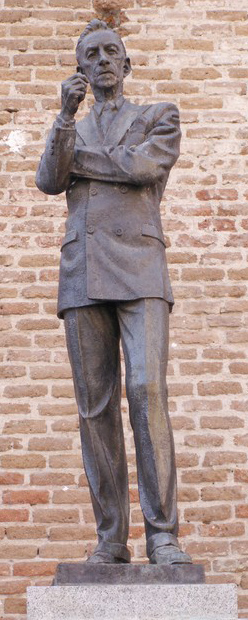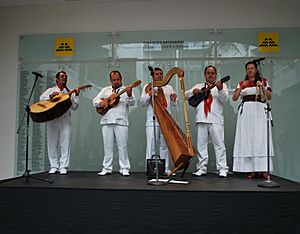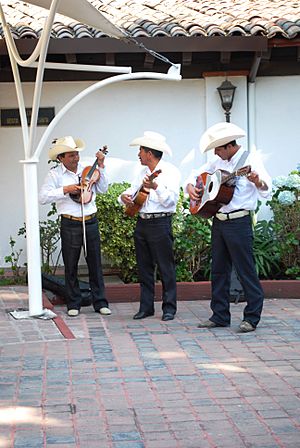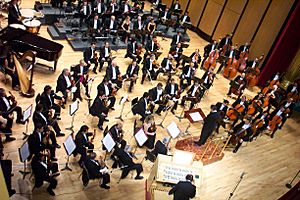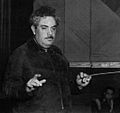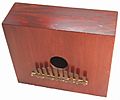Music of Mexico facts for kids
The music of Mexico is super diverse! It has many different styles and sounds. Mexican music has been shaped by many cultures. The most important influences come from native Mexican and European traditions. These influences started way back in the Late Middle Ages.
Some traditional Mexican songs are famous all over the world. For example, La Bamba is very well-known. Another popular song is La Cucaracha (The Cockroach). Even though it became famous during the Mexican Revolution, it's actually a Spanish song called a corrido.
Contents
Traditional Folk Music
Mexican Sones
Mexican sones are a type of music that mixes Spanish sounds with native music. Because of this mix, sones from different parts of Mexico sound unique. They have different rhythms and use various instruments.
Here are some examples of Mexican sones:
- Son Huasteco music comes from the Huasteca region. You can hear it in states like Hidalgo, Veracruz, San Luis Potosí, and Zacatecas. It often features a fiddle, a small guitar called a jarana huasteca, and a larger guitar called a huapanguera.
- Son jarocho is from the Veracruz area.
- Son jaliscience comes from Jalisco.
- Chilena music is from the Costa Chica region in Guerrero and Oaxaca.
- Calentano music is from the Tierra Caliente area.
- Abajeño music is found in Jalisco, Colima, and Michoacán.
Popular Music Styles
Banda Music
Banda music started by copying military bands. These bands were brought to Mexico in the 1860s by Emperor Maximilian I. Banda music sounds a lot like polka music.
Polish immigrants who settled in Sinaloa state helped make it popular. During the Mexican Revolution, local towns and leaders formed their own bands. Even revolutionary leaders like Pancho Villa traveled with wind bands.
Today, banda music is still very popular in central and northern Mexico. Many people connect banda with Sinaloa. This happened in the 1940s when the media shared music from Banda el Recodo. They made it seem like all banda music was from Sinaloa, even though it came from many regions.
Mariachi Music
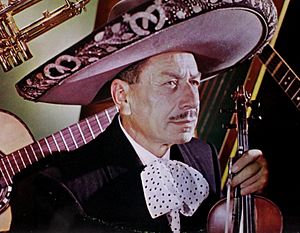
The Mariachi music style began in the state of Jalisco. It started in the city of Cocula, near Guadalajara. Mariachi is now popular all over Mexico and the Southwest United States. It is seen as a symbol of Mexican music and culture.
A mariachi band usually has five or more musicians. They wear special suits called charro suits. Traditional mariachi bands had at least two violins, a guitar, a large bass guitar called a guitarrón, and a vihuela. A vihuela is like a guitar but has a round back and plays higher notes. Today, mariachi bands also often include trumpets and sometimes a harp.
Norteño Music
Another important music style is musica Norteña, or northern tunes. This style has influenced other types of music, like musica de banda. Norteña music was shaped by Bohemian music and immigrant miners. Its rhythm comes from European polkas, which were popular in the 1800s.
Music with Latin American Roots
Cuban Influence
Rumba music came from enslaved people in Veracruz, Mexico City, and Yucatán. This style started in Cuba. Later, it became famous among the Black community in Mexico.
In the early 1900s, bolero music arrived in Yucatán. Danzón music came to Veracruz. Both styles became very popular across Mexico. Mexicans even developed their own versions of these rhythms.
In the 1940s, Cuban musicians like Pérez Prado and Benny Moré moved to Mexico. They brought the mambo with them. Mambo became super popular, especially in Mexico City. Later, mambo led to the Cha cha cha, which was also a big hit.
Cumbia
The history of Cumbia in Mexico is almost as old as Cumbia in Colombia. In the 1940s, Colombian singer Luis Carlos Meyer Castandet moved to Mexico. In the 1950s, he recorded La Cumbia Cienaguera. Many people think this was the first cumbia recorded outside of Colombia. This is when Cumbia started to become popular in Mexico.
Today, Cumbia is played in many different ways. It has small changes depending on the region. Some examples are Cumbia andina mexicana, Cumbia Norteña, and Tecno-cumbia.
Pop and Rock Music

The Mexican music market is a big stepping stone for many non-Mexican artists. It helps them reach more fans. Famous artists like Julio Iglesias, Enrique Iglesias, Shakira, Chayanne, Alejandro Sanz, and Ricky Martin became even bigger in Mexico.
In 2006, Mexico had over 90 hit songs in Latin America. This was almost a third more than the United States. Some of the most famous Mexican pop singers today include Luis Miguel, Alejandro Fernández, Thalía, Paulina Rubio, and Gloria Trevi.
Rock and Metal
The Mexican rock movement started in the late 1950s and early 1960s. It quickly became popular. It reached its peak in the 1980s and 1990s with unique Mexican sounds. One of the first Mexican rock bands was "Los Nómadas" (The Nomads). They were from East Los Angeles and were one of the first mixed-race bands in the 50s.
Mexican rock music often combines traditional Mexican instruments and stories. Mexican and Latin American rock music remains very popular in Mexico. It is even more popular than other types of rock and roll.
Classical Music
Mexico has a long history of classical music. It goes back to the 16th century when Mexico was a Spanish colony. Music from New Spain, especially by Juan Gutiérrez de Padilla and Hernando Franco, is now seen as a big part of New World culture.
In the 19th century, the waltzes by Juventino Rosas became famous worldwide. Manuel M. Ponce is known as an important composer for the Spanish classical guitar. He helped create more music for this instrument.
In the 20th century, Carlos Chávez was a notable composer. He wrote symphonies, ballets, and many chamber music pieces.
Images for kids
-
A statue in Mérida, Yucatán, of Pedro Infante. He, along with Jorge Negrete and Javier Solís, were known as the "Three Mexican Roosters" of Mexican music.
-
Carlos Chávez, a famous composer.
-
A bronze statue of José José, known as "El Príncipe de la Canción" (The Prince of Song) in Mexico City.
-
Aleks Syntek, a winner of three Latin Billboard awards and an Ariel award for Best Film Music.
-
Maná, a popular rock band.
-
Café Tacuba performing in Pontevedra, Spain.
-
Lila Downs at the "National Sor Juana Festival" in 2007.
-
Armando Manzanero, considered a top Mexican romantic composer after World War II.
-
Luis Miguel, known as "El Sol de Mexico" (The Sun of Mexico). His album 33 reached number 1 on Billboard's Latin Charts.
-
On September 28, 2010, Cristian Castro released the singles "La Nave del Olvido" and "Amor, Amor" from his tribute album to José José, Viva el Príncipe.
-
Celso Piña was a pioneer in mixing and blending tropical sounds.
-
Ángela Peralta, an operatic soprano.
-
Cuarteto Latinoamericano is a famous string quartet formed in Mexico in 1981.
-
Jaramar sings in the World Music genre.
See also
 In Spanish: Música de México para niños
In Spanish: Música de México para niños


